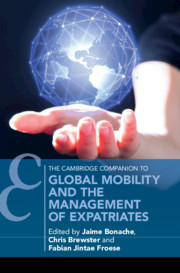Book contents
- Global Mobility and the Management of Expatriates
- Cambridge Companions to Management
- Global Mobility and the Management of Expatriates
- Copyright page
- Contents
- Figures
- Tables
- Contributors
- 1 Global Mobility
- Part I The Expatriation Process of Corporate Expatriates
- Part II Different Types of Expatriates and Stakeholders
- 7 Short-term Assignees, International Business Travellers, and International Commuters
- 8 Self-initiated Expatriates
- 9 Skilled Migrant Careers
- 10 Women and Global Mobility
- 11 Global Families
- 12 Roles and Challenges for Global Mobility Departments
- Index
- References
11 - Global Families
from Part II - Different Types of Expatriates and Stakeholders
Published online by Cambridge University Press: 12 November 2020
- Global Mobility and the Management of Expatriates
- Cambridge Companions to Management
- Global Mobility and the Management of Expatriates
- Copyright page
- Contents
- Figures
- Tables
- Contributors
- 1 Global Mobility
- Part I The Expatriation Process of Corporate Expatriates
- Part II Different Types of Expatriates and Stakeholders
- 7 Short-term Assignees, International Business Travellers, and International Commuters
- 8 Self-initiated Expatriates
- 9 Skilled Migrant Careers
- 10 Women and Global Mobility
- 11 Global Families
- 12 Roles and Challenges for Global Mobility Departments
- Index
- References
Summary
This chapter reviews the literature on the lynchpin of expatriate success and of global families – the expatriate partner. To better understand the adjustment and well-being of expatriate partners, we focused on three major correlates that represented partner, expatriate, and family aspects. We first identified various personal (i.e., demographic, traits, knowledge/skills/abilities/others, and attitudes/cognitions), relational, organizational, and assignment factors that are associated with the expatriate partner’s adjustment. For expatriate influences on partner adjustment and well-being, we considered both personal and job/assignment factors. For the family variables, we looked at the perspectives of both the partner and the expatriate. Through our analysis of these detected associations, we observed three major themes: crossover occurrences from partners to expatriates, the relationship between the partner and family dynamics, and under-researched topics relevant to partner adjustment. For each theme, we discuss what we currently know (or don’t know), relevant theoretical perspectives to advance our knowledge in these areas, and suggestions for future research.
Keywords
- Type
- Chapter
- Information
- Global Mobility and the Management of Expatriates , pp. 262 - 288Publisher: Cambridge University PressPrint publication year: 2020
References
- 1
- Cited by



